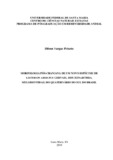| dc.creator | Peixoto, Dilson Vargas | |
| dc.date.accessioned | 2020-12-18T10:20:18Z | |
| dc.date.available | 2020-12-18T10:20:18Z | |
| dc.date.issued | 2019-02-26 | |
| dc.identifier.uri | http://repositorio.ufsm.br/handle/1/20226 | |
| dc.description.abstract | During the Cenozoic of South America, the terrestrial sloths (Folivora) had wide adaptive irradiation that culminated in a great diversity of forms during the Pleistocene. Except for some arboreal species, most sloths were extinguished at the end of this period. Among the clades included in Pilosa, Mylodontidae was one of the most representative, showing a large number of species. The largest species of this clade was Lestodon armatus, whose distribution occupied a large portion of the continent. In this work, a new and well-preserved specimen (UFSM 11535) assigned to L. armatus is reported. The specimen was found in a new fossiliferous locality designated Arroio do Lestodon in the Seival Valley, Caçapava do Sul, Rio Grande do Sul, Brazil. UFSM 11535 includes vertebrae, ribs, teeth, and an articulated hindlimb that include almost all bones. A detailed description of these post-cranial bones was provided as well as a comparison with other specimens. The taxonomic assignation of UFSM 11535 to L. armatus is based on the presence of the following characters: I) separation of the ectal and sustentacular facets in the astragalus; II) the function of the ectocuneiform as metatarsal II by the fusion of the two bones; III) odontoid process of the astragalus in the form of a pulley with about 90º in relation to the discoid facet; IV) separation by a crest of the astragali facets in the tibia, and V) the medial condyle of the femur larger than the lateral condyle. Among the contributions to the knowledge on the variation of post-cranial morphology, the fusion between fibula and tibia and the presence of two sesamoids in the metatarsal III was recorded for the first time in L. armatus. As future perspectives, more comprehensive analyzes of the post-cranial morphology of Mylodontidae and other sloths are necessary to verify the presence of individual anatomical variations, as well as to test the phylogenetic relevance of the characters present in this region of the skeleton. | eng |
| dc.description.sponsorship | Coordenação de Aperfeiçoamento de Pessoal de Nível Superior - CAPES | por |
| dc.language | por | por |
| dc.publisher | Universidade Federal de Santa Maria | por |
| dc.rights | Attribution-NonCommercial-NoDerivatives 4.0 International | * |
| dc.rights.uri | http://creativecommons.org/licenses/by-nc-nd/4.0/ | * |
| dc.subject | Megafauna | por |
| dc.subject | Anatomia pós-craniana | por |
| dc.subject | Pleistoceno | por |
| dc.subject | Mammalia | por |
| dc.subject | Xenarthra | por |
| dc.subject | Vale do Seival | por |
| dc.subject | Post-cranial anatomy | eng |
| dc.subject | Pleistocene | eng |
| dc.title | Morfologia pós-craniana de um novo espécime de Lestodon armatus Gervais, 1855 (Xenarthra, Mylodontidae) do quaternário do sul do Brasil | por |
| dc.title.alternative | Post-cranial morphology of a new specimen of Lestodon armatus Gervais, 1855 (Xenarthra, Mylodontidae) from southern Brazil | eng |
| dc.type | Dissertação | por |
| dc.description.resumo | Durante o Cenozoico da América do Sul, as preguiças-terrícolas (Folivora) apresentaram grande irradiação adaptativa que culminou em uma grande diversidade de formas durante o Pleistoceno. Com exceção de algumas espécies arborícolas, a maioria das preguiças foram extintas ao fim desse período. Dentre os Pilosa, Mylodontidae foi um dos clados mais representativos por conta da grande quantidade de espécies. A maior espécie desse foi Lestodon armatus, cuja distribuição ocupava grande parte do continente. Neste trabalho, reportamos um novo espécime (UFSM 11535) atribuído a L. armatus, o qual foi encontrado em bom estado de preservação em um novo sítio fossilífero chamado Arroio do Lestodon, no Vale do Seival, Caçapava do Sul, Rio Grande do Sul, Brasil. Além de vértebras, costelas, dentes e outros fragmentos, o que mais se destaca é a preservação de um dos membros posteriores em posição de articulação, evidenciando quase todos os ossos. Foi feita uma descrição detalhada dos ossos do pós-crânio do espécime, assim como comparação com outros espécimes. A atribuição a L. armatus se dá principalmente pela presença dos seguintes caracteres: I) separação das facetas ectal e sustentacular no astrágalo; II) função do ectocuneiforme como metatarsal II pela fusão dos dois ossos; III) pelo processo odontoide do astrágalo em forma de polia com cerca de 90º em relação à faceta discoide; IV) separação por uma crista das facetas astragalianas na tíbia, e V) côndilo medial do fêmur maior que o côndilo lateral. Entre os aportes sobre a variação da morfologia pós-craniana, registramos pela primeira vez o fusionamento entre fíbula e tíbia em L. armatus e a presença de dois sesamoides no metatarsal III. Como futuras perspectivas, análises mais abrangentes da morfologia pós-craniana dos Mylodontidae, bem como de outros pilosos, são necessárias para verificar a presença de variações anatômicas individuais, bem como testar a relevância filogenética dos caracteres presentes nesta região do esqueleto. | por |
| dc.contributor.advisor1 | Tumeleiro, Leonardo Rodrigo Kerber | |
| dc.contributor.advisor1Lattes | http://lattes.cnpq.br/8501464579034598 | por |
| dc.contributor.referee1 | Ribeiro, Ana Maria | |
| dc.contributor.referee1Lattes | http://lattes.cnpq.br/9260792624083196 | por |
| dc.contributor.referee2 | Rosa, Atila Augusto Stock da | |
| dc.contributor.referee2Lattes | http://lattes.cnpq.br/9474621147155251 | por |
| dc.creator.Lattes | http://lattes.cnpq.br/6754146683514345 | por |
| dc.publisher.country | Brasil | por |
| dc.publisher.department | Bioquímica | por |
| dc.publisher.initials | UFSM | por |
| dc.publisher.program | Programa de Pós-Graduação em Biodiversidade Animal | por |
| dc.subject.cnpq | CNPQ::CIENCIAS BIOLOGICAS::BIOQUIMICA | por |
| dc.publisher.unidade | Centro de Ciências Naturais e Exatas | por |



